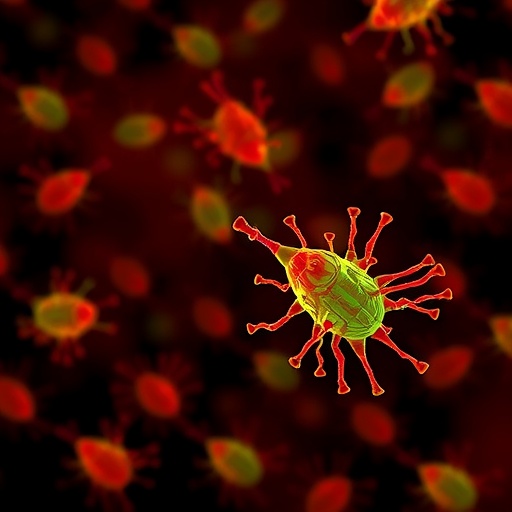In a groundbreaking advance that promises to reshape the landscape of food safety and medical therapeutics alike, researchers have uncovered compelling evidence highlighting the dual role of bacteriophages JEP7 and PBC2 as both antimicrobials targeting foodborne pathogens and modulators of immune responses in mammalian cells. This discovery emerges from a study published in Food Science and Biotechnology, marking a significant leap forward in harnessing bacteriophages not only to combat bacterial infections but also to engage with the mammalian immune system through cytokine activation.
Bacteriophages, viruses that specifically infect bacteria, have long been regarded as natural enemies of bacterial pathogens, offering a potential alternative to antibiotics amid rising antimicrobial resistance. The novel research executed by Jung, Y., Kim, J., Lee, JH., and their colleagues introduces previously unexplored complexity: these phage entities, JEP7 and PBC2, when introduced into mammalian systems, initiate distinct cytokine responses. Cytokines are crucial signaling proteins that orchestrate immune defense mechanisms, inflammation, and tissue repair, and the implication that phages themselves might trigger such responses unveils new dimensions for therapeutic innovation.
The study meticulously evaluated the interaction between these two bacteriophages and foodborne pathogens, confirming their potent antibacterial activity. Both JEP7 and PBC2 demonstrated specificity in lysing harmful bacteria typically implicated in food contamination, such as Salmonella and Escherichia coli strains. This specificity underscores their value as precision antimicrobials that can diminish bacterial burden without disturbing beneficial microbiota—a striking advantage over broad-spectrum antibiotics.
What sets this research apart is the detailed investigation of mammalian cellular responses to phage exposure. Utilizing cultured mammalian immune cells, the researchers monitored changes in cytokine profiles upon phage administration. They observed that JEP7 and PBC2 facilitated the secretion of pro-inflammatory cytokines such as TNF-α, IL-6, and IL-1β, which are essential in mounting effective innate immune responses. Simultaneously, regulatory cytokines were also modulated, suggesting a nuanced immune balancing act rather than a simple inflammatory trigger.
Such findings challenge the traditional view that bacteriophages are passive players within higher organisms, instead positioning them as active participants in immune modulation. This immune interplay might have implications far beyond antibacterial therapy. For instance, phages could potentially be leveraged to prime the immune system against infections or even cancer, reigniting interest in phage therapy as a multifaceted biomedical tool.
Furthermore, the research illuminated the molecular mechanisms underlying the cytokine responses. Through advanced transcriptomic analyses, the researchers identified signaling pathways and receptor interactions activated upon phage exposure. Toll-like receptors (TLRs), known sentinels in pathogen recognition, appeared to mediate much of this cytokine induction. This insight bridges bacteriophage biology with mammalian innate immunity, revealing evolutionary intersections that could be exploited for therapeutic gain.
Safety concerns are paramount when considering any bacteriophage application in human health, and the study addressed this with rigorous cytotoxicity assays. Notably, neither JEP7 nor PBC2 induced harmful effects on mammalian cell viability at therapeutically relevant concentrations, thus supporting their feasibility as safe immunomodulatory agents. Moreover, their inability to replicate within mammalian cells alleviates fears of unintended viral propagation or genotoxicity.
The potential applications stemming from these findings extend into food safety regulations and clinical practices. For the food industry, deploying such phages could revolutionize contamination control by eliminating pathogens while stimulating subtle immune enhancement upon ingestion, potentially fortifying mucosal defenses. In clinical settings, these phages might complement existing antimicrobial regimes, especially in immunocompromised patients, by activating host defenses in tandem with bacterial clearance.
The discovery also invites a new paradigm where bacteriophage therapy could be tailored to modulate immune responses selectively. By engineering phages like JEP7 and PBC2, scientists might customize cytokine profiles to treat autoimmune diseases, chronic inflammation, or even to boost vaccine efficacy. This versatility elevates bacteriophages from mere bacterial killers to sophisticated immunotherapeutic platforms.
Yet, with exciting possibilities come challenges and unknowns. The long-term immunological consequences of sustained phage exposure remain to be fully elucidated. Could persistent cytokine induction lead to undesired inflammation or immune exhaustion? The current study provides a crucial first step but underscores the necessity for extended in vivo studies and clinical trials to map these dynamics comprehensively.
In summary, the research led by Jung and colleagues represents a landmark in bacteriophage science, merging microbiology and immunology to uncover how phages JEP7 and PBC2 can address foodborne pathogens while strategically engaging mammalian immune cells. This dual-action profile heralds a new frontier in phage therapy with profound implications for public health, food safety, and immunotherapy.
As antimicrobial resistance escalates into a global crisis, novel interventions like bacteriophage-based immune modulators become invaluable. The intricate dance between JEP7 and PBC2 phages and mammalian cytokines offers a promising path forward, where microbial predators serve as allies in augmenting human immunity.
Future research will undoubtedly expand on this foundation, exploring additional phage types, refining delivery methods, and decoding the complex immunological networks influenced by phage contact. The convergence of synthetic biology, immunology, and microbiology promises to translate these discoveries into practical interventions that may one day redefine how we approach infectious diseases and immune-related conditions.
Ultimately, the revelation that bacteriophages are more than mere bacterial killers but also immune system influencers marks a transformative step in biomedical science. The remarkable capabilities of JEP7 and PBC2 exemplify the untapped potential lurking within the virosphere—offering hope, innovation, and new weapons in humanity’s fight against microbial threats.
Subject of Research: Interaction of bacteriophages JEP7 and PBC2 with foodborne pathogens and their elicitation of cytokine responses in mammalian cells
Article Title: Bacteriophages JEP7 and PBC2, which target foodborne pathogens, elicit cytokine responses in mammalian cells
Article References:
Jung, Y., Kim, J., Lee, JH. et al. Bacteriophages JEP7 and PBC2, which target foodborne pathogens, elicit cytokine responses in mammalian cells. Food Sci Biotechnol (2025). https://doi.org/10.1007/s10068-025-02042-3
Image Credits: AI Generated
DOI: 26 November 2025
Tags: antimicrobial resistance alternativesbacterial infection treatmentbacteriophages JEP7 and PBC2cytokine signaling proteinsdual role of bacteriophagesfood safety innovationsfoodborne pathogen controlimmune response modulationinflammation and tissue repairmammalian cytokine activationphage therapy researchtherapeutic applications of bacteriophages





